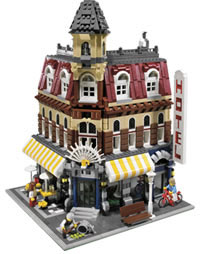Walkable urbanism has arrived…
…when LEGO now sells sets to build mixed-use, street-facing model Victorian townhouses with apartments above retail.
I loved to build LEGO sets growing up, but back then, almost all LEGO sets fit into one of three lines: Castle, Space, or Town (suburban-style development). They later added Pirate. In Town, we had the gas station, airport, single-family houses, and more, all on large, green plates connected by road plates. There was a train station, of course, but the small-town commuter rail type. That was the way people saw the built environment in those days.
Today, LEGO makes a lot more (like Star Wars and SpongeBob SquarePants sets). But they’ve renamed Town to City. Today’s City sets still mostly feature emergency response vehicles and infrastructure like ports and airports (the things kids like), but as Planetizen reports, they also now make some mixed-use urban buildings, including a green grocer with apartments above, and a corner cafe below a hotel.
Of course, LEGO is a European company, and Europe’s cities have always looked like this. And they still sell the suburban gas station. Perhaps reflecting the actual value of urban buildings versus suburban, the gas station sells for $39.99 and the greengrocer for $149.99. Like real historic urban buildings compared to new suburban cookie-cutter development, the townhouse sets have much more detail. (They’re also aimed at a much older audience.)
At yesterday’s panel, Christopher Leinberger also talked about pop culture’s reflection of urbanism versus suburbanism, using an anecdote that also appears in The Option of Urbanism. We know that our attitudes have changed, he said, because while baby boomers’ TV shows depicted families in the suburbs (like The Brady Bunch and The Dick Van Dyke Show), today’s the next generation’s hottest sitcoms take place in cities, such as Friends and Seinfeld and many since.
In January 1957, Leinberger explained, Lucy of I Love Lucy moved from Manhattan to a suburb in Connecticut. In a subsequent episode, she had Fred and Ethel visit “to see her new suburban splendor.” Then they moved out there. “The Baby Boomers’ image [of cities] was Hill Street Blues and Fort Apache in the Bronx,” he said. In an episode of Sex and the City, one of the characters walks down a narrow Manhattan street at night. “The boomers think she’s going to get mugged. The millenials think she’s going to a glamorous art gallery,” which is exactly where she’s going, safely.


